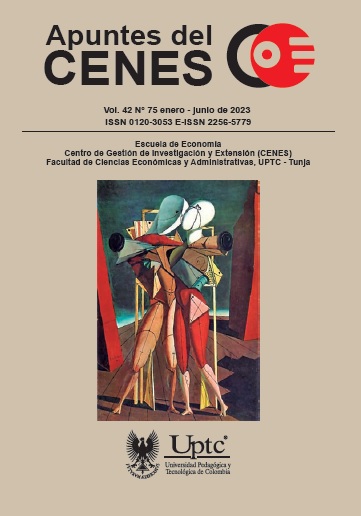Los “spillovers” del COVID-19 sobre el empleo y el ingreso en Perú

Resumen
En este trabajo se estiman los efectos spillovers (de derrame) del COVID-19 sobre empleo (total, formal e informal) e ingresos reales de un grupo de provincias del Perú denominadas “tratadas o de tratamiento”, en el período del virus 2020-II-2021-IV. Estos spillovers se asocian al comportamiento de las personas que incumplieron el confinamiento, se aglomeraron en espacios relativamente pequeños, no usaron medidas de protección contra el COVID-19. Las mediciones de estos efectos se apoyan en Cao y Dowd (2019) y en la Encuesta Nacional de Hogares del INEI-ENAHO (2022) del período 2011.I-2021-IV, que es la base de datos principal del estudio. Dos resultados principales del estudio son, por un lado, que el COVID-19 y las políticas de confinamiento y transferencias a pobres y empresas contribuyeron en promedio en más del 50 % del decrecimiento del empleo total, el formal y el ingreso real (de la población económicamente activa ocupada provincial), y al incremento de la informalidad para el grupo de provincias tratadas. Por otro lado, los efectos spillovers atenuaron los efectos negativos de la disminución del empleo formal y del ingreso real de dichas provincias.
Palabras clave
COVID-19, efectos spillovers , desempleo, distribucción del ingreso, Peru
Archivo(s) complementario(s)
(Apéndice)Referencias
- Abadie, A. (2021). Using Synthetic Controls: Feasibility, Data Requirements, and Methodological Aspects. Journal of Economic Literature. 59(2), 391-425. https://doi.org/10.1257/jel.20191450 DOI: https://doi.org/10.1257/jel.20191450
- Andrews, D. W. K. (2003). End-of-Sample Instability Tests. Econometrica, 71(6),1661-1694. https://doi.org/10.1111/1468-0262.00466 DOI: https://doi.org/10.1111/1468-0262.00466
- Angrist, J., Imbens, G. & Rubin, D. (1996). Identification of Causal Effects Using Instrumental Variables. Journal of the American Statistical Association, 91(434), 444-455. https://doi.org/10.1080/01621459.1996.10476902 DOI: https://doi.org/10.1080/01621459.1996.10476902
- Banco Central de Reserva del Perú. (BCRP). (2022). Estadísticas. BCRP.
- Cao J., & Dowd, C. (2018). Estimation and Inference for Synthetic Control Methods with Spillover Effects. PPT. University of Chicago Booth School of Business.
- Cao J., & Dowd, C. (2019). Estimation and Inference for Synthetic Control Methods with Spillover Effects. University of Chicago Booth School of Business.
- Cox., D. (1958). Planning of Experiments. John Wileys & Sons.
- Cunningham, S. (2021). Causal Inference the Mixtape. Yale University Press, New Haven & London. https://doi.org/10.12987/9780300255881 DOI: https://doi.org/10.12987/9780300255881
- Di Stefano R., & Mellace, G. (2020). The Inclusive Synthetic Control Method. Department of Methods and Models for Economics, Territory and Finance. Sapienza University of Rome Via del Castro Laurenziano, Mimeo. https://doi.org/10.2139/ssrn.3737491 DOI: https://doi.org/10.2139/ssrn.3737491
- Ferman, B., & Pinto, C. (2021). Synthetic Controls with Imperfect Pre-treatment Fit. Quantitative Economics,12(4). https://doi.org/10.3982/QE1596 DOI: https://doi.org/10.3982/QE1596
- Grossi, G., Mariani, M., Mattei, A., Lattarulo, P., & Oner, O. (2021). Synthetic Control Group Methods in the Presence of Interference: The Direct and Spillover Effects of Light Rail on Neighborhood Retail Activity. Mimeo. Cambridge University.
- Green, D., & Gerber, A. (2010). The Stable Unit Treatment Value Assumption (SUTVA) and Its Implications for Social Science RCTs. In Presentation at the Conference on Empirical Legal Studies, Yale Law School, November 5, 2010. https://community.lawschool.cornell.edu/wp-content/uploads/2020/12/Green-presentation-on-SUTVA-for-CELS.pdf
- Green, D., & Gerber, A. (2012). Field Experiments: Design, Analysis, and Interpretation. Norton.
- Huntington-Klein, N. (2022). The Effect an Introduction to Research Design and Causality. CRC Press. https://doi.org/10.1201/9781003226055 DOI: https://doi.org/10.1201/9781003226055
- INEI 2022. Estadísticas de seguridad ciudadana. INEI. https://www.inei.gob.pe/biblioteca-virtual/boletines/estadisticas-de-seguridad-ciudadana/1/
- INEI-ENAHO. (2022). Encuesta Nacional de Hogares, años del 2011 al 2020. INEI.
- Jaramillo, M., & López, K. (2021). Políticas para combatir la pandemia de COVID-19. Grade Documento de Investigación, (12). https://www.grade.org.pe/publicaciones/politicas-para-combatir-la-pandemia-de-covid-19/Johns Hopkins (s.f.). COVID-19 Map. Johns Hopkins University. https://coronavirus.jhu.edu/map.html
- Lim J., Maung, S., Tan, S., Ong, J., Lim, J., Koo, H., Sun, M., Park, K., TanI, J., Yoong, A., Cook, B. & Dickens, L. (2021). Estimating Direct and Spill-over Impacts of Political Elections on COVID-19 Transmission Using Synthetic Control Methods. PLOS Computational Biolog., 1-15. https://doi.org/10.1371/journal.pcbi.1008959 DOI: https://doi.org/10.1371/journal.pcbi.1008959
- Ministerio de Economía y Finanzas (MEF). (2022). Transparencia Económica. Mineco. https://apps5.mineco.gob.pe/bingos/mantenimiento/Navegador/default.aspx
- MINSA. (2022). Estadísticas del COVID 19. MINSA. https://covid19.minsa.gob.pe/sala_situacional.asp
- Mitze J., Kosfeld, R., Rode, J. & Wälde, K. (2020). Face Masks Considerably Reduce COVID-19 Cases in Germany. PNAS, 117(51), pp. 1-9, https://doi.org/10.1073/pnas.2015954117 DOI: https://doi.org/10.1073/pnas.2015954117
- Mundo LR. (2020, 20 dic.). Perú es noticia en el mundo por aglomeraciones en compras navideñas. La República. https://larepublica.pe/mundo/2020/12/20/peru-es-noticia-en-el-mundo-por-aglomeraciones-en-compras-navidenas/Our World Data. (2022). COVID-19 Data. https://ourworldindata.org/
- Redacción Perú 21. (2020, 11 abr.). Coronavirus en Perú: Problemas para congelar alimentos en hogares habrían contribuido a aglomeraciones. Perú 21. https://peru21.pe/economia/problemas-para-congelar-alimentos-en-hogares-habrian-contribuido-a-aglomeraciones-noticia/?ref=p21r
- Rubin D. (1980). Randomization Analysis of Experimental Data: The Fisher Randomization Test Comment. Journal of the American Statistical Association, 75(371), 591-593. https://doi.org/10.1080/01621459.1980.10477517 DOI: https://doi.org/10.2307/2287653
- Shi, C., Sridhar, D., Misra, V., & Blei, D. (2022). On the Assumptions of Synthetic Control Methods. In Proceedings of the 25th International Conference on Artificial Intelligence and Statistics (AISTATS) 2022, Valencia, España.
- Tello, M.D. (2022). Controles sintéticos y estrategia de dosis: un análisis provincial exploratorio de los efectos del COVID-19 en los ingresos, empleo y pobreza en el Perú, 2011-2020. Informe final CIES.
- World Bank. (2022). World Development Indicators. World Bank.
- Zhang, Z., Owen, G., Green, M., Buchan, I., &Barr, B. (2022). Evaluating the Impacts of Tiered Restrictions Introduced in England, During October and December 2020 on COVID-19 Cases: A Synthetic Control Study. BMJ Open,12(4), 1-7. http://dx.doi.org/10.1136/bmjopen-2021-054101 DOI: https://doi.org/10.1136/bmjopen-2021-054101
- Zhou, F., Yu, T., Du, R., Fan, G., Liu, Y., & Liu, Z. (2020). Clinical Course and Risk Factors for Mortality of Adult Inpatients with COVID-19 in Wuhan, China: A Retrospective Cohort Study. Lancet, 395(10229), 1054-1062. https://doi.org/10.1016/S0140-6736(20)30566-3 DOI: https://doi.org/10.1016/S0140-6736(20)30566-3
